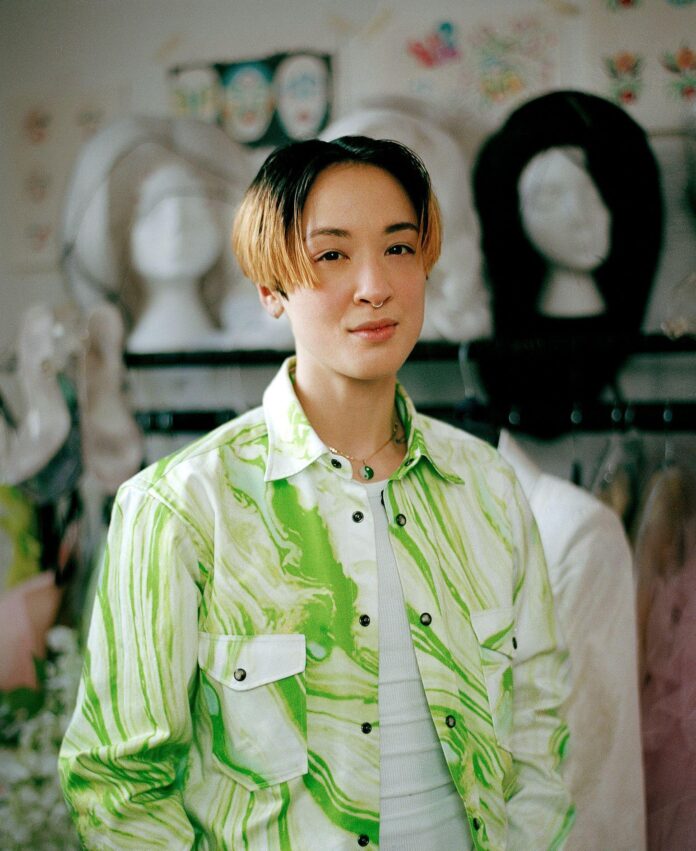Videos might be a hard sell at fairs, but they can help catch the attention of key tastemakers—a strategy that has paid off for the London-based, Chinese-Canadian artist Sin Wai Kin, who is one of two artists to win this year’s Baloise Art Prize for presentations in the Statements section of Art Basel 2023.
Sin receives the $33,000 award for their solo stand with the London gallery Soft Opening, in which they show five, 10-minute long videos of characters, played by Sin, sitting down for portraits. Their heavily stylised appearances are based on costumes from Cantonese and Peking opera, while also referencing portraits by the likes of Frida Kahlo and Caravaggio.

Installation view of Sin Wai Kin: Portraits, Soft Opening, Art Basel 2023 – Statements
Photo: Mark Blower
Established in 1999, the Baloise prize has spotted talents such as Haegue Yang and Tino Sehgal early in their careers. Through the award, Sin’s work will be collected by the institutions MMK Frankfurt and Mudam in Luxembourg.
Sin’s is already a familiar name to many. The artist was nominated for last year’s Turner Prize, for which they showed the film A Dream of Wholeness in Parts (2021), which examines and skews perceived binaries of reality and fantasy, and performance and authenticity. Through their practice, the non-binary Sin argues that such black-and-white constructs are heavily dependent on identity. “Growing up, things that resembled my life were almost never depicted in realistic or mainstream narratives, but more so in science fiction and fantasy,” they say. “I’ve always been interested in how the positionality of a storyteller defines whether their story is interpreted as fact or fiction.”

Sin Wai Kin’s Dreaming the End (film still) (2023)
© The artist. Courtesy the artist and Fondazione Memmo, Rome
These themes are further explored in an ongoing solo show of Sin’s work at the Fondazione Memmo in Rome, Dreaming the End (until 29 October). The show takes its name from a central film that depicts two characters, the Storyteller and the Construct, both played by Sin, who transform into one another, and appear in theatrical costumes and makeup based on Cantonese opera. The film portrays a dreamlike state of suspended reality, and its inhabitants are shown grappling with questions of selfhood in relation to their names and gender identities.
Shot in Rome across four days, the film makes use of some of the Eternal City’s grandest backdrops, including the gardens of the Villa Medici. The 20th-century Italian filmmakers Dario Argento and Federico Fellini, who both famously set works in the Italian capital, were among Sin’s many stylistic inspirations. “Rome is not a city you can just bring your own narrative to,” Sin says. “It is a city built on top of cities. Everywhere you turn there is a monument of political gravitas—art history is unavoidable here.”

Sin Wai Kin’s Dreaming the End (film still) (2023)
© The artist. Courtesy the artist and Fondazione Memmo, Rome
Such towering legacies are of particular interest for Sin. “Italy is full of examples of how histories are cemented in architecture and art, which are then presented to us as the true or natural outcome of human culture—often without noticing. It’s an example of how humans shape the context that then shapes us again in turn.”
This pertains not just to Rome’s ancient buildings, but its Fascist architecture too. Speaking of one of the film’s backdrops, the Palazzo della Civilta Italiana, which is part of a wider complex initiated in 1935 by the dictator Benito Mussolini, Sin says: “The rationalist architecture style attempts to demonstrate an aesthetic of purity and logic without any emotion, and present it as an inevitability of history that it is really a facade for violent and oppressive ideologies which are in fact illogical and based on fear, hatred and unchecked biases. In the film I use the building as a facade for the inside world, in which constructed narratives and names are enforced, gender is binary, and the character of Change must learn the rules of their context in order to survive before they become aware that there are other ways to exist.”

Sin Wai Kin’s Embodied Image (2017)
Courtesy the artist and Soft Opening, London
Photography: Theo Christelis
Also in the Memmo show are several busts wearing the wigs used in the film, as well as a number of Sin’s signature makeup wipe works, which bear the ghostly imprints of the blush, eyeshadow, foundation and lipstick they have worn in the film. “I’ve been doing the makeup wipe works for as long as I’ve been doing drag,” Sin says. The artist cut their teeth in the London drag scene in the early 2010s, and while they no longer actively perform in drag, the culture still heavily influences their work. “These works mean a lot of different things to me—an archive, a remnant, or even a death mask of a performance that can never be repeated again.”
Much like the near-static portraits in Art Basel, the makeup wipe works break down the fourth wall of Sin’s film practice. “Revealing the construction of the thing while also presenting the thing is exactly what drag is about,” Sin says, returning, as they tend to do, to an overarching preoccupation with story telling. “Once we are conscious of the act of storytelling in everything we do, we have the ability to change narratives.”

























